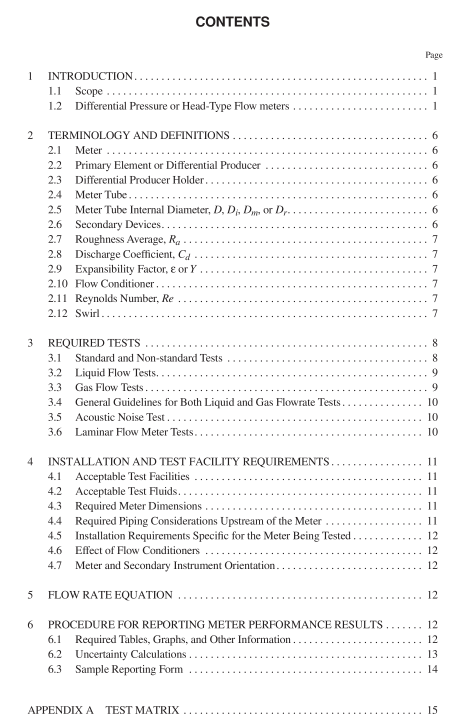API MPMS 5.7 pdf download

API MPMS 5.7 pdf download Manual of Petroleum Measurement Standards Chapter 5—Metering Section 7—Testing Protocol for Differential Pressure Flow Measurement Devices
3 Required Tests
3.1 STANDARD AND NON-STANDARD TESTS Two types of tests are required for this protocol, namely Standard and Non-standard Tests. The purpose of the Stan- dard Test is to test the flow meter in flow conditions that has fully developed symmetrical velocity profile, which has no appreciable swirl (swirl angle less than 2°). The purpose of non-standard flow conditions is to test the meter in common industrial metering situations with asymmetrical velocity pro- files and significant swirl. It is the responsibility of the manufacturer to specify the allowable range of differential pressures to be used with spe- cific fluids, based on the thermodynamic properties of fluids as well as mechanical and fluid mechanical constraints. In no case shall the differential pressures in these tests exceed the limits imposed by mechanical and fluid mechanical constraints. The effect of static pressure on differential pressure transmitters is a separate technical issue and is addressed in 2.6.2.
In typical industrial flow rates, the maximum liquid velocity is ≅ 30 ft/s (10 m/s) and gas velocity is ≅ 90 ft/s (30 m/s). For some meters the associated differential pressure may be excessively high at these stated velocities. In such a case, the maximum fluid velocities shall be lower than those given above and shall not produce a differential pressure which exceeds the manufacturer’s maximum allowable limit.
The test report must state the maximum velocities and differential pressures observed during the tests. For compressible fluid flows and the low-pressure test, if the manufacturer specifies a limit on the maximum value of ∆P/P 1 , the maximum veloc- ity for the test must be limited to account for the allowable limit of ∆P/P 1 for the meter. Significant temperature changes may influence the performance of differential pressure flow meters through the change of critical geometrical parameters and fluid properties. Meter manufacturers have to specify cor- rections to be used in data processing. For flow velocities in piping in excess of Mach 0.25, a correction has to be made to the static temperature reading (see 2.6.3). It is generally impractical to change the fluid temperature in a flow labora- tory; consequently, the flowing fluid temperature should sim- ply be recorded.
3.1.1 Required Flow Conditions for Standard Tests and Non-Standard Tests
3.1.1.1 Standard Tests The standard tests are designed to establish a meter’s per- formance under fully developed ideal flowing conditions. If the test facility requires that a flow conditioner be used, the flow conditioner must be installed upstream of the meter tube. The inlet of the meter being tested should be located at the position of the inlet of the reference orifice meter that was used to establish the replication of the Reader-Harris & Gal- lagher (R-G) equation (see 4.1).
The meter tube, including a flow conditioner, if required by the meter manufacturer, will be tested for the Standard Condition. As described in 3.2 and 3.3, this protocol requires the Stan- dard Tests at two significantly different pressures. The two test pressures are mandatory for gas testing but optional for liquid testing. For gas flows, the high pressure must be at least five times the low pressure. If the meter is offered for ANSI 600 # flange rating or more, the high pressure test should be at least 800 psi (5.5 MPa).
3.1.1.2 Non-Standard Tests The following three non-standard tests are required to eval- uate a meter’s performance in common industrial non-ideal flow conditions. These tests highlight the worst-case scenario encountered in practical applications, without introducing artificially extreme conditions. If a flow conditioner is used with the meter, it must be explicitly stated in the published results. Tests will be carried out for the manufacturer’s meter installed directly down- stream of the following three non-standard conditions.
In each case, flow entering the disturbance must have a symmet- rical flow pattern and no swirl, as in 3.1.1.1. The manufac- turer must define the distance of the following disturbances to the primary element being tested and record these distances in the test report (see 6.3).
a) Two adjoining (close coupled) out-of-plane 90° elbows (long radius): Installing these piping elements immediately upstream of the meter will generate a moderate swirl and flow profile asymmetry. The spacing between the end of the curved portion of the first elbow and the beginning of the curved por- tion of the second elbow shall not exceed two pipe diameters (2D i ).
b) A half-moon orifice plate (asymmetric flow profile): Installing this device immediately upstream of the meter will generate a strong asymmetric axial velocity profile.
c) Swirl generator: Installing this device immediately upstream of the meter will generate high swirl.









